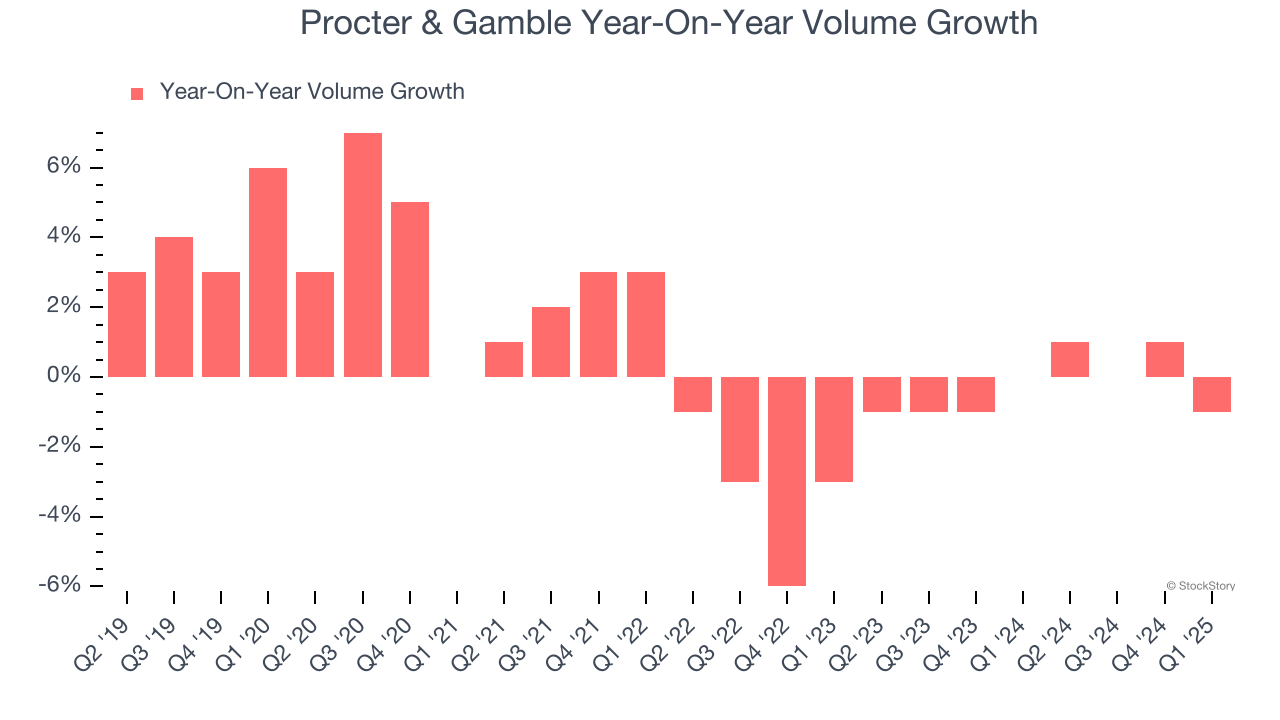
Consumer products behemoth Proctor & Gamble (NYSE: PG) missed Wall Street’s revenue expectations in Q1 CY2025, with sales falling 2.1% year on year to $19.78 billion. Its non-GAAP profit of $1.54 per share was 0.9% above analysts’ consensus estimates.
Is now the time to buy Procter & Gamble? Find out by accessing our full research report, it’s free.
Procter & Gamble (PG) Q1 CY2025 Highlights:
- Revenue: $19.78 billion vs analyst estimates of $20.15 billion (2.1% year-on-year decline, 1.9% miss)
- Adjusted EPS: $1.54 vs analyst estimates of $1.53 (0.9% beat)
- Adjusted EBITDA: $7.05 billion vs analyst estimates of $5.40 billion (35.6% margin, 30.4% beat)
- Management lowered its full-year Adjusted EPS guidance to $6.77 at the midpoint, a 3% decrease
- Operating Margin: 23%, in line with the same quarter last year
- Free Cash Flow Margin: 14.4%, down from 16.3% in the same quarter last year
- Organic Revenue was flat year on year (3% in the same quarter last year)
- Sales Volumes fell 1% year on year (0% in the same quarter last year)
- Market Capitalization: $388.6 billion
Company Overview
Founded by candle maker William Procter and soap maker James Gamble, Proctor & Gamble (NYSE: PG) is a consumer products behemoth whose product portfolio spans everything from facial tissues to laundry detergent to feminine care to men’s grooming.
Household Products
Household products stocks are generally stable investments, as many of the industry's products are essential for a comfortable and functional living space. Recently, there's been a growing emphasis on eco-friendly and sustainable offerings, reflecting the evolving consumer preferences for environmentally conscious options. These trends can be double-edged swords that benefit companies who innovate quickly to take advantage of them and hurt companies that don't invest enough to meet consumers where they want to be with regards to trends.
Sales Growth
Examining a company’s long-term performance can provide clues about its quality. Any business can put up a good quarter or two, but the best consistently grow over the long haul.
With $83.93 billion in revenue over the past 12 months, Procter & Gamble is one of the most widely recognized consumer staples companies. Its influence over consumers gives it negotiating leverage with distributors, enabling it to pick and choose where it sells its products (a luxury many don’t have). However, its scale is a double-edged sword because it’s harder to find incremental growth when your existing brands have penetrated most of the market. To accelerate sales, Procter & Gamble likely needs to optimize its pricing or lean into new products and international expansion.
As you can see below, Procter & Gamble’s 1.8% annualized revenue growth over the last three years was sluggish as it failed to grow its volumes. We’ll explore what this means in the "Volume Growth" section.

This quarter, Procter & Gamble missed Wall Street’s estimates and reported a rather uninspiring 2.1% year-on-year revenue decline, generating $19.78 billion of revenue.
Looking ahead, sell-side analysts expect revenue to grow 3.3% over the next 12 months. While this projection indicates its newer products will spur better top-line performance, it is still below average for the sector. At least the company is tracking well in other measures of financial health.
Software is eating the world and there is virtually no industry left that has been untouched by it. That drives increasing demand for tools helping software developers do their jobs, whether it be monitoring critical cloud infrastructure, integrating audio and video functionality, or ensuring smooth content streaming. Click here to access a free report on our 3 favorite stocks to play this generational megatrend.
Volume Growth
Revenue growth can be broken down into changes in price and volume (the number of units sold). While both are important, volume is the lifeblood of a successful staples business as there’s a ceiling to what consumers will pay for everyday goods; they can always trade down to non-branded products if the branded versions are too expensive.
To analyze whether Procter & Gamble generated its growth from changes in price or volume, we can compare its volume growth to its organic revenue growth, which excludes non-fundamental impacts on company financials like mergers and currency fluctuations.
Over the last two years, Procter & Gamble’s quarterly sales volumes have, on average, stayed about the same. This stability is normal as the quantity demanded for consumer staples products typically doesn’t see much volatility. The company’s flat volumes also indicate its average organic revenue growth of 3.6% was generated from price increases.

In Procter & Gamble’s Q1 2025, sales volumes dropped 1% year on year. This result represents a further deceleration from its historical levels, showing the business is struggling to move its products.
Key Takeaways from Procter & Gamble’s Q1 Results
We were impressed by how significantly Procter & Gamble blew past analysts’ EBITDA expectations this quarter. On the other hand, its revenue missed, and it lowered its full-year EPS guidance. Zooming out, we think this was a mixed quarter. The areas below expectations seem to be driving the move, and the stock traded down 1.5% to $163.10 immediately following the results.
So should you invest in Procter & Gamble right now? When making that decision, it’s important to consider its valuation, business qualities, as well as what has happened in the latest quarter. We cover that in our actionable full research report which you can read here, it’s free.


